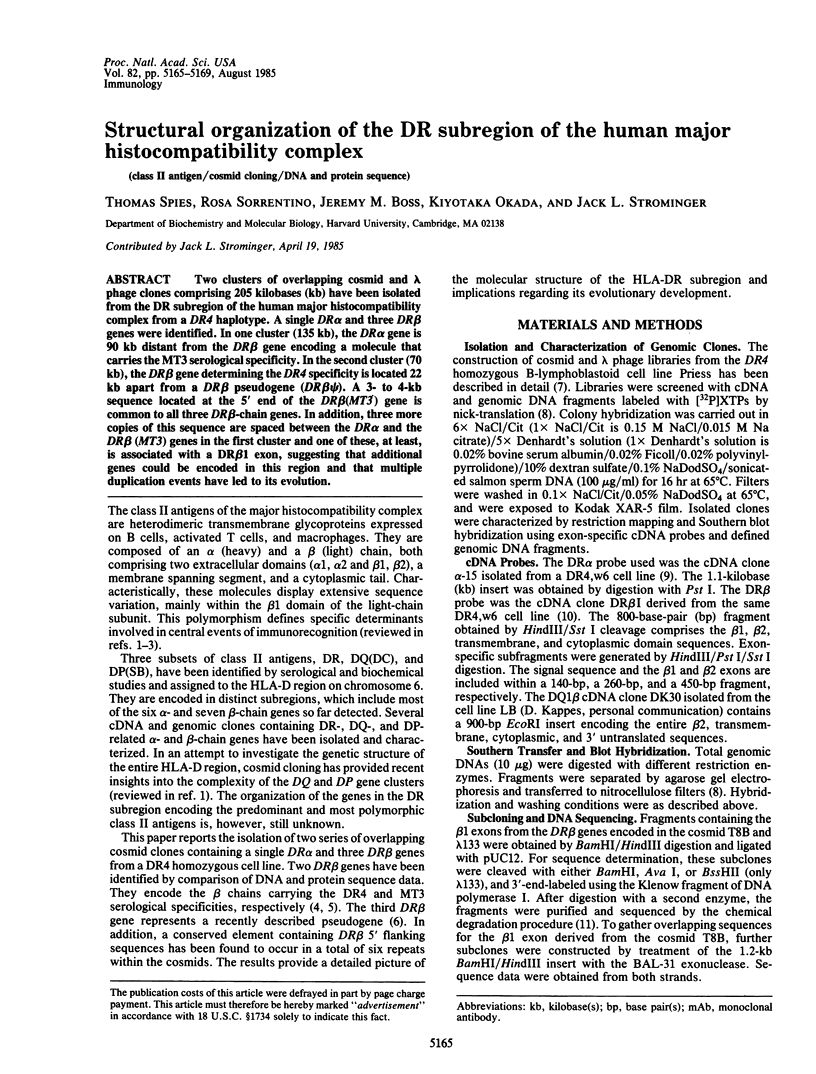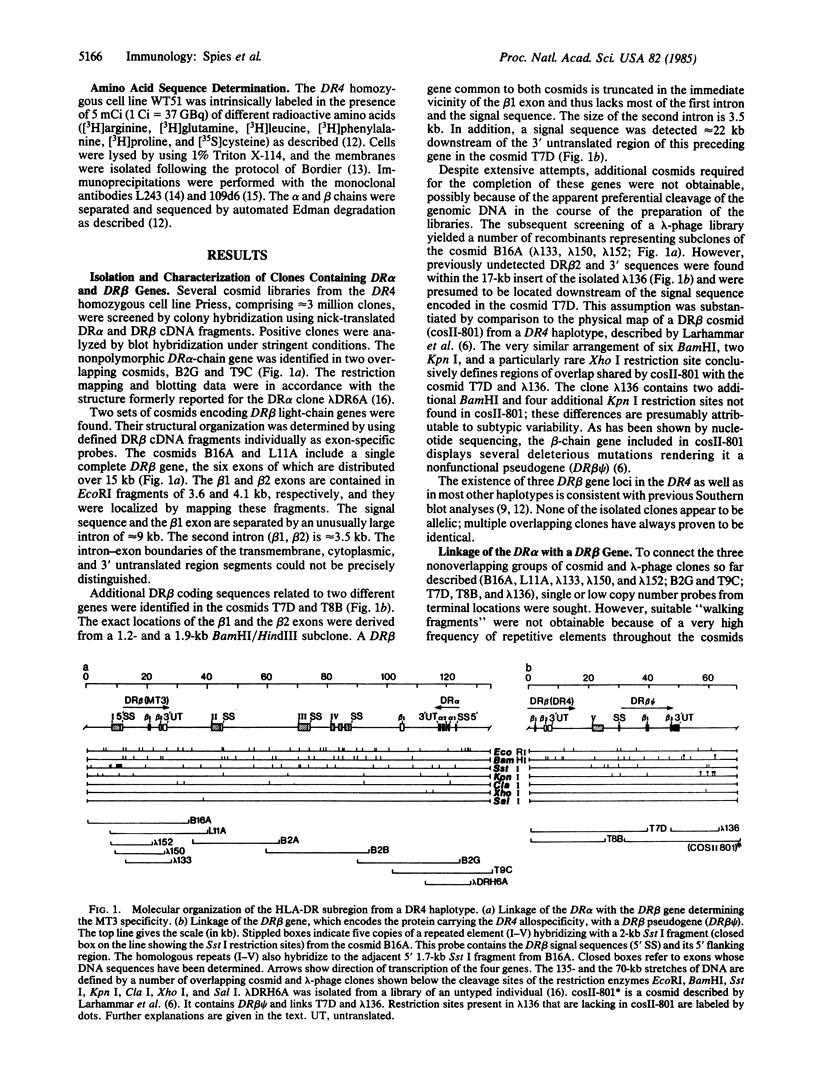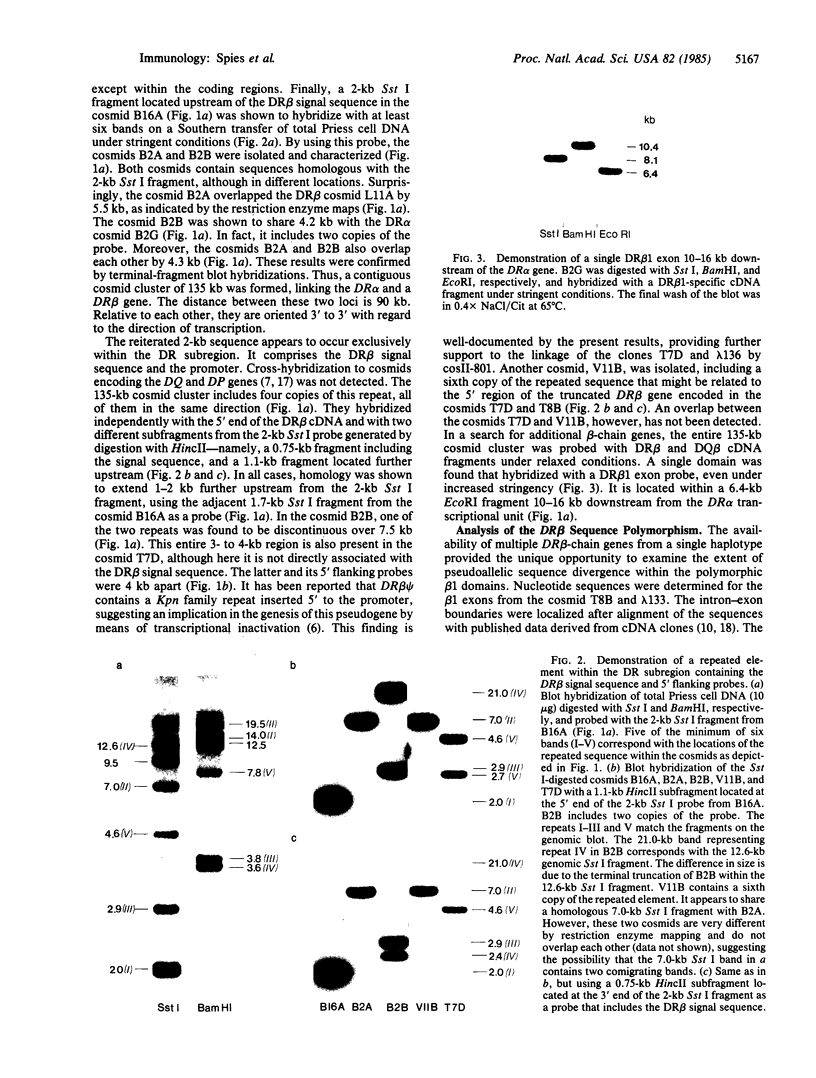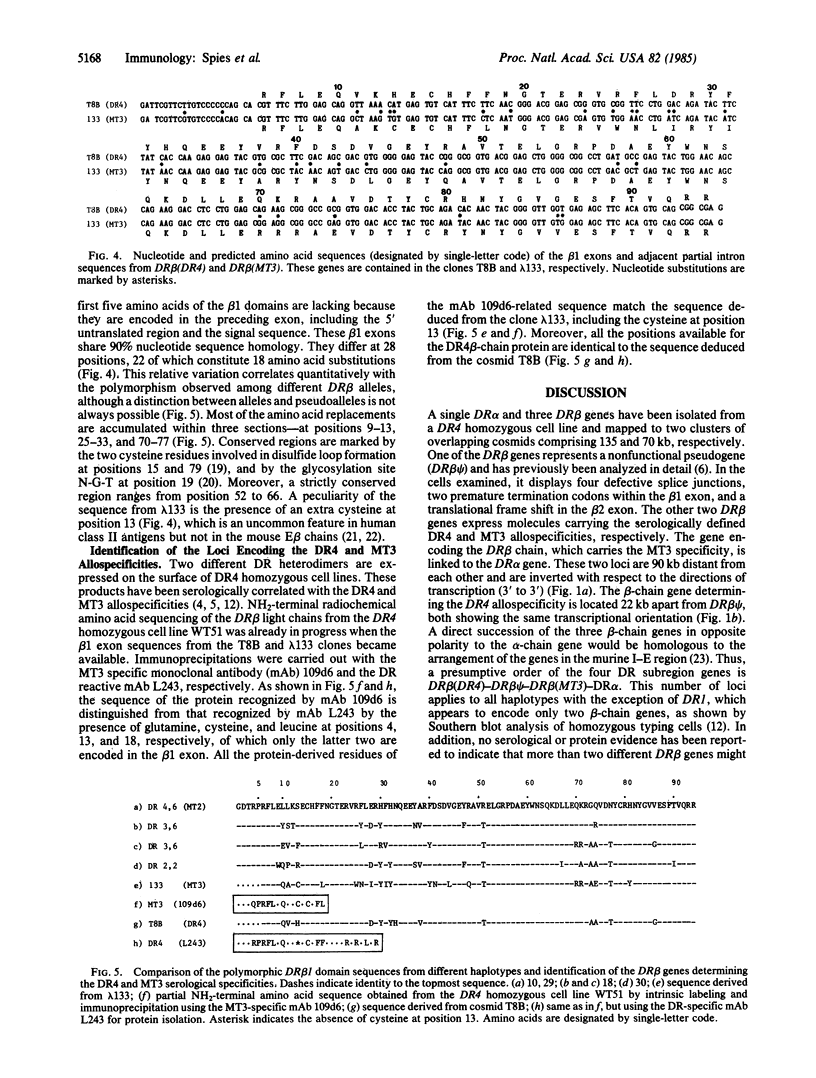Abstract
Two clusters of overlapping cosmid and lambda phage clones comprising 205 kilobases (kb) have been isolated from the DR subregion of the human major histocompatibility complex from a DR4 haplotype. A single DR alpha and three DR beta genes were identified. In one cluster (135 kb), the DR alpha gene is 90 kb distant from the DR beta gene encoding a molecule that carries the MT3 serological specificity. In the second cluster (70 kb), the DR beta gene determining the DR4 specificity is located 22 kb apart from a DR beta pseudogene (DR beta psi). A 3- to 4-kb sequence located at the 5' end of the DR beta (MT3) gene is common to all three DR beta-chain genes. In addition, three more copies of this sequence are spaced between the DR alpha and the DR beta (MT3) genes in the first cluster and one of these, at least, is associated with a DR beta 1 exon, suggesting that additional genes could be encoded in this region and that multiple duplication events have led to its evolution.
Full text
PDF




Images in this article
Selected References
These references are in PubMed. This may not be the complete list of references from this article.
- Albert E., Mayr W. Brief summary of Ninth International Histocompatibility Workshop. Tissue Antigens. 1985 Jan;25(1):3–10. doi: 10.1111/j.1399-0039.1985.tb00405.x. [DOI] [PubMed] [Google Scholar]
- Bach F. H., Watson A. J. Dw/LD associated molecular polymorphism of DR4 beta-chains: intramolecular localization of polymorphic sites. J Immunol. 1983 Oct;131(4):1622–1625. [PubMed] [Google Scholar]
- Bordier C. Phase separation of integral membrane proteins in Triton X-114 solution. J Biol Chem. 1981 Feb 25;256(4):1604–1607. [PubMed] [Google Scholar]
- Gillies S. D., Folsom V., Tonegawa S. Cell type-specific enhancer element associated with a mouse MHC gene, E beta. Nature. 1984 Aug 16;310(5978):594–597. doi: 10.1038/310594a0. [DOI] [PubMed] [Google Scholar]
- Gustafsson K., Wiman K., Emmoth E., Larhammar D., Böhme J., Hyldig-Nielsen J. J., Ronne H., Peterson P. A., Rask L. Mutations and selection in the generation of class II histocompatibility antigen polymorphism. EMBO J. 1984 Jul;3(7):1655–1661. doi: 10.1002/j.1460-2075.1984.tb02026.x. [DOI] [PMC free article] [PubMed] [Google Scholar]
- Hurley C. K., Giles R. C., Nunez G., DeMars R., Nadler L., Winchester R., Stastny P., Capra J. D. Molecular localization of human class II MT2 and MT3 determinants. J Exp Med. 1984 Aug 1;160(2):472–493. doi: 10.1084/jem.160.2.472. [DOI] [PMC free article] [PubMed] [Google Scholar]
- Kaufman J. F., Strominger J. L. HLA-DR light chain has a polymorphic N-terminal region and a conserved immunoglobulin-like C-terminal region. Nature. 1982 Jun 24;297(5868):694–697. doi: 10.1038/297694a0. [DOI] [PubMed] [Google Scholar]
- Korman A. J., Auffray C., Schamboeck A., Strominger J. L. The amino acid sequence and gene organization of the heavy chain of the HLA-DR antigen: homology to immunoglobulins. Proc Natl Acad Sci U S A. 1982 Oct;79(19):6013–6017. doi: 10.1073/pnas.79.19.6013. [DOI] [PMC free article] [PubMed] [Google Scholar]
- Kratzin H., Yang C. Y., Götz H., Pauly E., Kölbel S., Egert G., Thinnes F. P., Wernet P., Altevogt P., Hilschmann N. Primärstruktur menschlicher Histokompatibilitätsantigene der Klasse II. 1. Mitteilung: Aminosäuresequenz der N-terminalen 198 Reste der beta-Kette des HLA-Dw2,2;DR2,2-Alloantigens. Hoppe Seylers Z Physiol Chem. 1981 Dec;362(12):1665–1669. [PubMed] [Google Scholar]
- Lampson L. A., Levy R. Two populations of Ia-like molecules on a human B cell line. J Immunol. 1980 Jul;125(1):293–299. [PubMed] [Google Scholar]
- Larhammar D., Servenius B., Rask L., Peterson P. A. Characterization of an HLA DR beta pseudogene. Proc Natl Acad Sci U S A. 1985 Mar;82(5):1475–1479. doi: 10.1073/pnas.82.5.1475. [DOI] [PMC free article] [PubMed] [Google Scholar]
- Long E. O., Wake C. T., Gorski J., Mach B. Complete sequence of an HLA-dR beta chain deduced from a cDNA clone and identification of multiple non-allelic DR beta chain genes. EMBO J. 1983;2(3):389–394. doi: 10.1002/j.1460-2075.1983.tb01435.x. [DOI] [PMC free article] [PubMed] [Google Scholar]
- Maxam A. M., Gilbert W. Sequencing end-labeled DNA with base-specific chemical cleavages. Methods Enzymol. 1980;65(1):499–560. doi: 10.1016/s0076-6879(80)65059-9. [DOI] [PubMed] [Google Scholar]
- Mengle-Gaw L., McDevitt H. O. Isolation and characterization of a cDNA clone for the murine I-E beta polypeptide chain. Proc Natl Acad Sci U S A. 1983 Dec;80(24):7621–7625. doi: 10.1073/pnas.80.24.7621. [DOI] [PMC free article] [PubMed] [Google Scholar]
- Nepom B. S., Nepom G. T., Mickelson E., Antonelli P., Hansen J. A. Electrophoretic analysis of human HLA-DR antigens from HLA-DR4 homozygous cell lines: correlation between beta-chain diversity and HLA-D. Proc Natl Acad Sci U S A. 1983 Nov;80(22):6962–6966. doi: 10.1073/pnas.80.22.6962. [DOI] [PMC free article] [PubMed] [Google Scholar]
- Okada K., Boss J. M., Prentice H., Spies T., Mengler R., Auffray C., Lillie J., Grossberger D., Strominger J. L. Gene organization of DC and DX subregions of the human major histocompatibility complex. Proc Natl Acad Sci U S A. 1985 May;82(10):3410–3414. doi: 10.1073/pnas.82.10.3410. [DOI] [PMC free article] [PubMed] [Google Scholar]
- Okada K., Prentice H. L., Boss J. M., Levy D. J., Kappes D., Spies T., Raghupathy R., Mengler R. A., Auffray C., Strominger J. L. SB subregion of the human major histocompatibility complex: gene organization, allelic polymorphism and expression in transformed cells. EMBO J. 1985 Mar;4(3):739–748. doi: 10.1002/j.1460-2075.1985.tb03691.x. [DOI] [PMC free article] [PubMed] [Google Scholar]
- Shackelford D. A., Strominger J. L. Analysis of the oligosaccharides on the HLA-DR and DC1 B cell antigens. J Immunol. 1983 Jan;130(1):274–282. [PubMed] [Google Scholar]
- Sorrentino R., Lillie J., Strominger J. L. Molecular characterization of MT3 antigens by two-dimensional gel electrophoresis, NH2-terminal amino acid sequence analysis, and southern blot analysis. Proc Natl Acad Sci U S A. 1985 Jun;82(11):3794–3798. doi: 10.1073/pnas.82.11.3794. [DOI] [PMC free article] [PubMed] [Google Scholar]
- Steinmetz M., Hood L. Genes of the major histocompatibility complex in mouse and man. Science. 1983 Nov 18;222(4625):727–733. doi: 10.1126/science.6356354. [DOI] [PubMed] [Google Scholar]
- Toguchi T., Burmester G., Nunez-Roldan A., Gregersen P., Seremetis S., Lee S., Szer I., Winchester R. Evidence for the separate molecular expression of four distinct polymorphic Ia epitopes on cells of DR4 homozygous individuals. Hum Immunol. 1984 Jun;10(2):69–81. doi: 10.1016/0198-8859(84)90074-0. [DOI] [PubMed] [Google Scholar]
- Unanue E. R., Beller D. I., Lu C. Y., Allen P. M. Antigen presentation: comments on its regulation and mechanism. J Immunol. 1984 Jan;132(1):1–5. [PubMed] [Google Scholar]
- Wake C. T., Long E. O., Mach B. Allelic polymorphism and complexity of the genes for HLA-DR beta-chains--direct analysis by DNA-DNA hybridization. Nature. 1982 Nov 25;300(5890):372–374. doi: 10.1038/300372a0. [DOI] [PubMed] [Google Scholar]
- Waters S. J., Winchester R. J., Nagase F., Thorbecke G. J., Bona C. A. Antigen presentation by murine and human cells to a murine T-cell hybridoma: demonstration of a restriction element associated with a major histocompatibility complex class II determinant(s) shared by both species. Proc Natl Acad Sci U S A. 1984 Dec;81(23):7559–7563. doi: 10.1073/pnas.81.23.7559. [DOI] [PMC free article] [PubMed] [Google Scholar]
- Widera G., Flavell R. A. The nucleotide sequence of the murine I-E beta b immune response gene: evidence for gene conversion events in class II genes of the major histocompatibility complex. EMBO J. 1984 Jun;3(6):1221–1225. doi: 10.1002/j.1460-2075.1984.tb01956.x. [DOI] [PMC free article] [PubMed] [Google Scholar]
- Winchester R., Toguchi T., Szer I., Burmester G., Lo Galbo P., Cuttner J., Capra J. D., Nunez-Roldan A. Association of susceptibility to certain hematopoietic malignancies with the presence of Ia allodeterminants distinct from the DR series; utility of monoclonal antibody reagents. Immunol Rev. 1983;70:155–166. doi: 10.1111/j.1600-065x.1983.tb00713.x. [DOI] [PubMed] [Google Scholar]







